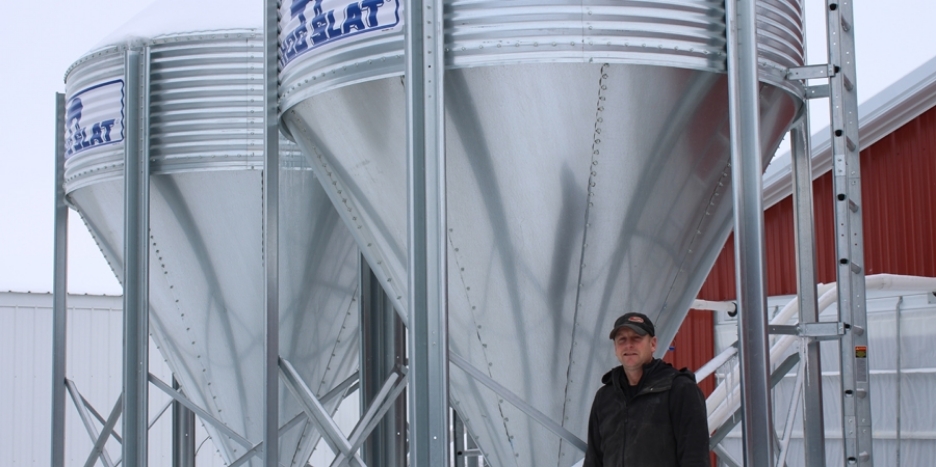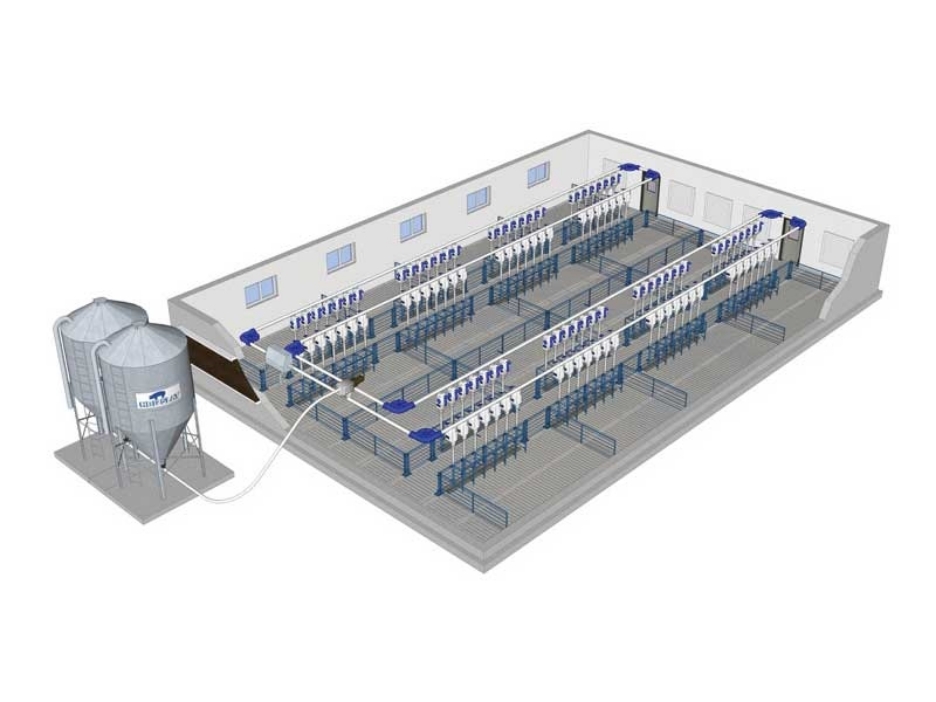Blog posts tagged with 'stanchions'
Evaluating new technology should be based on three critical factors…does it fit, will we use the information, and will it make us more profitable?
By Fritz Richards, Sales Manager, Hog Slat Inc.
We just returned from the EuroTier show held in Hanover, Germany. Billed as the largest animal production trade fair in the world this year's theme was "Digital Animal Farming." Many of the equipment manufacturers highlighted sensor technology designed to measure everything from humidity, lighting, behavior, estrous, etc. and link the data to Artificial Intelligence systems.
In the middle of this overwhelming display of "smart farming" it pays to take a moment to consider the real value of all this technology. “Smart Farming” does not mean that you have every piece of high tech equipment on your farm that is available. “Smart Farming” is maximizing your profitability by utilizing the correct combination of technology and quality products.
Every production system is different, whether it's a single farm or a large integrated model spread over many locations.
First, each production system needs to evaluate new products with a critical eye to determine if it fits their system.
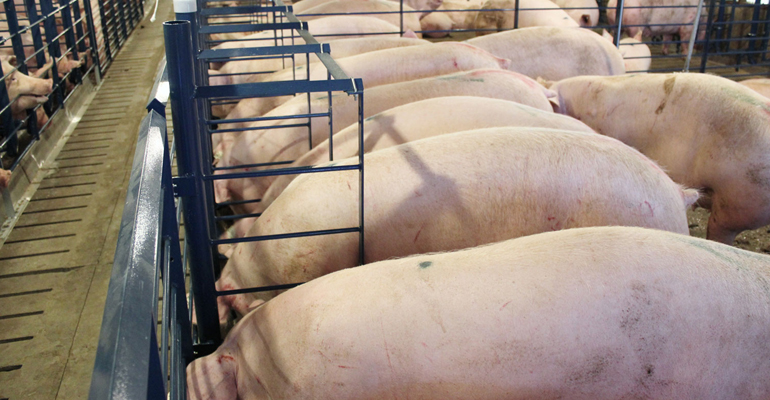
Let's take the example of group sow housing. For a farm with a stable workforce and low turnover, electronic sow feeding could be an excellent choice for loose housing. Forcing the same ESF equipment on a production system with higher employee turnover would not yield as good of results. It would be easier to train employees and maintain the equipment with a less intensive system using stanchions and drop feeding — less technology but better results.
The second criterion for evaluating new technology is will the production system utilize this new information.
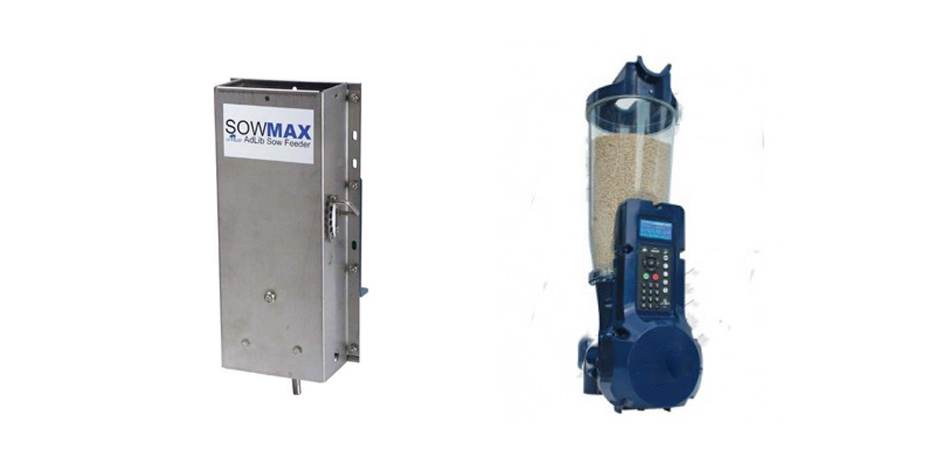
Consider feeding sows for maximum performance in lactation. Installing a trigger activated SowMAX dispenser will increase productivity and reduce labor and wastage compared to hand feeding. Installing an electronically activated hopper will yield similar results and record the metered amount of feed to a central record keeping system. The evaluation must then be, is this additional information worth the higher cost and increased maintenance? How will this new information be used to make better management decisions?
The third and the absolutely most important evaluation for any new technology is it should LOWER COSTS AND IMPROVE PROFITS.
The cost of computerized ventilation controllers is easily recoupled through increased growth rates due to the improved environment, but adding additional features only increases cost with little chance for payback. Take the example of a recent project where the owner wanted to connect the ventilation control to his smartphone at a cost of $10,000. This additional expense would not have significantly improved pig performance and would have only put him in a weaker financial position.
Now don't get this wrong, we're not backward thinking Luddites opposed to all new technology, but we think for "smart farming” to be truly smart it has to pass the following criteria.
1) Does it fit the current production system and personnel?
2) Will the information indeed be used to make better management decisions?
3) And most importantly does it increase productivity AND PROFIT?
Some new “smart farming” technology only increases data overload and offers very little new information to make smarter decisions. Is it really necessary to individually monitor every animal on a 5,000-
Careful and thoughtful evaluation will ensure all new products and technology contribute to a farm’s overall profits.
Fritz Richards is the sales manager for Hog Slat Inc.’s swine business division. Fritz can be reached frichards@hogslat.com.
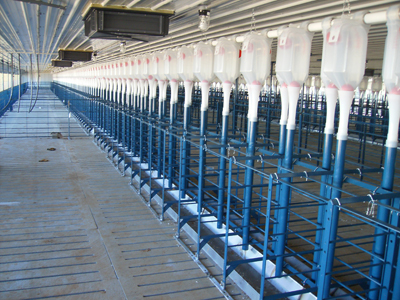 As the swine industry searches for alternatives to stall gestation, another option has emerged and is in the process of being refined. Stanchion Housing refers to short stall-like dividers that are added to open pen gestation to separate and protect the animals as they are fed. It is a refinement over traditional open pens where sow are fed on the floor and group size must be limited to reduce fighting.
As the swine industry searches for alternatives to stall gestation, another option has emerged and is in the process of being refined. Stanchion Housing refers to short stall-like dividers that are added to open pen gestation to separate and protect the animals as they are fed. It is a refinement over traditional open pens where sow are fed on the floor and group size must be limited to reduce fighting.
To date all the systems have been designed with standard gestation stalls in which the sows are weaned and remain until they are bred and preg checked. Typically this would be about a 45 day inventory of the total sow numbers.
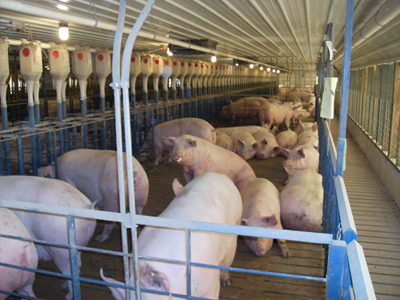 Looking at the total number of animals in a breeding group, a decision can be made on total numbers of sows per pen. Current stanchion systems range from 10 head per pen all the way up to over a hundred. Many producers choose to break a farrowing group into two or three different pens as this allows for grading and sorting weaned animals by body score. Placing sows in similar groups reduces fighting and allows for uniform feeding.
Looking at the total number of animals in a breeding group, a decision can be made on total numbers of sows per pen. Current stanchion systems range from 10 head per pen all the way up to over a hundred. Many producers choose to break a farrowing group into two or three different pens as this allows for grading and sorting weaned animals by body score. Placing sows in similar groups reduces fighting and allows for uniform feeding.
After total number of sows per pen is determined, the next design consideration is the amount of square footage per animal. Current EU welfare regulations require 24 sq ft. and some producers have chosen to follow that guideline, but systems exist that range from this level all the way down to 17 sq ft./sow.
Two critical design elements have proved themselves in the existing layouts. 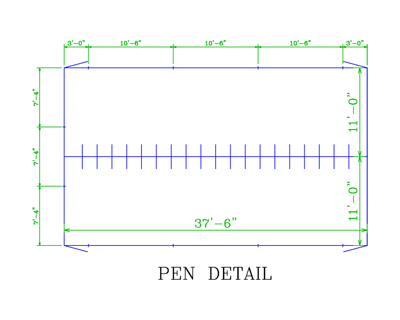 First, long narrow pens are preferred as this prevents a boss sow from blocking feed stanchions. The second design feature is placing the stanchions head to head in the center of the pen rather than placing them along the alleys. Because the stanchions are not in the alleys, the sows can be viewed from the rear during feeding for problems. It also allows for easier animal movement in and out of the pens as the gates are not part of the stanchions. In addition, the number of feed lines needed is reduced.
First, long narrow pens are preferred as this prevents a boss sow from blocking feed stanchions. The second design feature is placing the stanchions head to head in the center of the pen rather than placing them along the alleys. Because the stanchions are not in the alleys, the sows can be viewed from the rear during feeding for problems. It also allows for easier animal movement in and out of the pens as the gates are not part of the stanchions. In addition, the number of feed lines needed is reduced.
The first stanchion systems featured trickle feed equipment where the feed slowly dribbled in front of the sows at meal time, the idea being a slow placement of feed in front of the sows would hold them in the stalls and prevent boss sows from “wolfing down” their feed and moving up and down the line stealing feed. In practice, the additional cost and upkeep of a trickle system did not justify its use and has been omitted on new installations. Current systems use standard feed drops that dump the entire ration into stainless steel troughs or on a solid concrete floor.
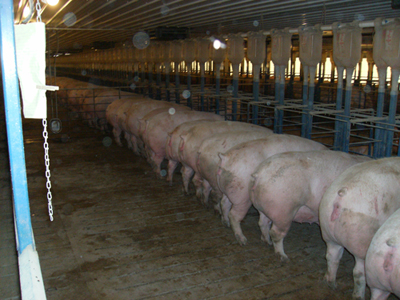 Equipment used in a head-to-head layout consists of stanchions that are 40” tall and 19” long. These dimensions protect the face and ears of the individual sow from aggressive pen mates. Ideal width has been determined to be 20” as this prevents other sows from crowding in to steal feed. Early systems used solid dividers; as we gained more experience with head-to-head systems, the use of open dividers was adopted. The Hog Slat equipment used to configure this layout is an adaption of our standard gestation stall which has been used throughout the industry for over 30 years. The stanchions are constructed of solid horizontal rods with angle top and bottom rails, the entire unit bolts together with galvanized floor spacers and double top spacers for added stability. This style of stanchion fits completely with the standard 40” gestation penning used in the rest of the pen layout. The result is a well-designed system that goes together without a great deal of “field fabrication”. AquaChief cup waterers are added at the rate of one per 11 animals to provide fresh water.
Equipment used in a head-to-head layout consists of stanchions that are 40” tall and 19” long. These dimensions protect the face and ears of the individual sow from aggressive pen mates. Ideal width has been determined to be 20” as this prevents other sows from crowding in to steal feed. Early systems used solid dividers; as we gained more experience with head-to-head systems, the use of open dividers was adopted. The Hog Slat equipment used to configure this layout is an adaption of our standard gestation stall which has been used throughout the industry for over 30 years. The stanchions are constructed of solid horizontal rods with angle top and bottom rails, the entire unit bolts together with galvanized floor spacers and double top spacers for added stability. This style of stanchion fits completely with the standard 40” gestation penning used in the rest of the pen layout. The result is a well-designed system that goes together without a great deal of “field fabrication”. AquaChief cup waterers are added at the rate of one per 11 animals to provide fresh water.
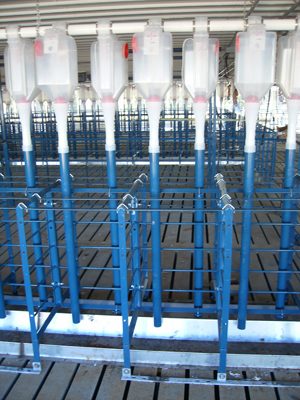 Many of the stanchion systems are remodels, the layout of which has to be adapted to existing slat /solid configurations. If building new projects most producers opt for using total slats as this allows for more flexibility in the event of changes in the welfare regulations.
Many of the stanchion systems are remodels, the layout of which has to be adapted to existing slat /solid configurations. If building new projects most producers opt for using total slats as this allows for more flexibility in the event of changes in the welfare regulations.
Stanchion systems require a high degree of stockmanship to operate successfully. Boss sows must be culled ruthlessly and individual care of animals is more difficult than standard stall systems. However, for many production systems, stanchions are a better alternative than Electronic Sow Feeding. Stanchions allow group housings of animals without the costs and high maintenance associated with ESF stations.
For more information please contact your local Hog Slat rep or contact us by email at frichards@hogslat.com.
- 2026
- 2025
- 2024
- 2023
- 2022
- 2021
- 2020
- 2019
- 2018
- 2017
- 2016
- 2015
- 2013












 Україна
Україна Méjico
Méjico